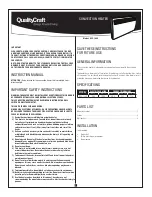
LAARS Heating Systems
Page 28
differential/2.
2. Target Max
- The boiler target maximum is
the point at which the stages will start to turn off to
maintain a maximum water temperature. The Boiler
Maximum water temperature is set by setting dip
switch #4: Boiler Maximum 210°F (Off) / 190°F (On).
To ensure that the water temperature is less than
the Boiler Maximum water temperature the target is
decreased to allow the stages to cycle off by the Boiler
Maximum water temperature, Boiler Maximum target
is set to Boiler Maximum - differential/2.
Auto Differential
The control automatically
adjusts differential to prevent short cycling and
maximize the lifetime of components.
WWSD Operation
Warm Weather Shutdown -
WWSD feature is selected via dip switch #3, WWSD
Inactive (Off) / Active 70°F (On). WWSD point is
fixed at 70 deg F. Control exits WWSD when the
outdoor temp falls to 65 F. When there is a call for
HEAT and the control is in WWSD the HEAT call will
be ignored. When there is a call for DHW and the
control is in WWSD the DHW call will be satisfied.
WWSD LED turns on when control detects WWSD.
Summary of Input Sensors:
1. Outdoor sensor - monitors the outside air
temperature for outdoor reset mode
2. Boiler outlet sensor -monitors the water
temperature of the boiler outlet supply
3. System Supply sensor - monitors the water
temperature of the system supply
The boiler outlet sensor is required at all times.
If the boiler outlet sensor has any fault then the control
will flash an error and turns all stages off. The system
supply sensor is optional and utilizes
primary / secondary piping. If the system supply
sensor has a fault then the control flashes an error
message and operates using the boiler outlet sensor
(system supply = boiler outlet).
6.3 External Boiler Operations
Use the field interlock ( T-T terminals ) that are
inside control box.
6.4 Sequence of Operation
If a field-supplied pump is properly wired to the
unit, or if the unit is pump-mounted, the pump will be
energized.
Once the water flow switch makes, if all of the
safety interlocks are closed, the ignition module will
energize the blower(s) for a 15-second pre-purge,
followed by a 40-second period to allow the ignitor to
heat.
The ignition control energizes the blower. The
blower pressurizes the air box (which supplies air to
the burners) and closes the normally-open contact
on the airflow pressure switch. The blocked vent
pressure switch senses the pressure in the exhaust
plenum. This switch opens if the pressure is excessive
(as an indicator of a blocked vent). When these two
pressure switches are closed, voltage is sent to the
PSW terminal on the ignition control, which allows the
ignition module to proceed with the ignition sequence.
If the airflow proving circuit is not proven,
ignition module will lock out.
Section 6.5
describes
the result of air flow faults in more detail.
When the ignition control gets the signal at the
PSW terminal, it will energize its MV terminal, which
sends power to the stage one (or on/off) main valve.
After a 7-second trial for ignition, the ignitor
switches to flame sense mode. If a flame is not
detected, the gas valve will close and the ignition
module will attempt ignition again (up to two more
times, for a total of three attempts.) If all three
attempts fail, the ignition control will lock out.
If flame is sensed, the burner will continue to
fire as long as there is a call for heat, and none of the
safety circuit is interrupted.
If there is a call for stage 2 on a 2-stage unit, that
valve will be energized.
If there is a loss of flame signal during a
successful firing sequence, the ignition control will
remove power from the gas valves, and then attempt to
light up to two more times. If successful, the Mighty
Therm2 will fire normally. If unsuccessful, the ignition
control will lock out.
When the call for heat is satisfied, the gas
valve(s) closes, and the blower starts a 45 second
post-purge, and the pump starts the post-purge (where
applicable).
6.5 Ignition Control Reaction to Air Flow /
Blocked Vent Pressure Switch
Air flow and blocked vent status are continuously
monitored by the Mighty Therm2 ignition control, at
the control’s PSW terminal.
At the start of an ignition sequence, if the ignition
control sees power at PSW for 30 seconds, but the
combustion blower has not yet been energized by the
control (F1 and F2), the ignition control will remain
in this fault mode, with the blower off. If the power to
PSW is removed while there is still a call for heat, the
ignition sequence will start again, but the main valves
will not be energized until PSW sees power during the
ignition sequence.
If the PSW signal is lost while the Mighty
Therm2 is firing, the control will immediately de-
energize the gas valve terminal (MV). The blower will
remain on for the post-purge period (45 seconds), and
the control will continue to monitor the PSW input.
If the signal is detected during the post-purge period,
a normal trial for ignition will begin, starting with
the 15-second pre-purge. If the signal is not detected
during the post-purge, the control will lockout with the















































